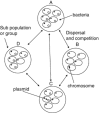What traits are carried on mobile genetic elements, and why?
- PMID: 20332804
- PMCID: PMC3183850
- DOI: 10.1038/hdy.2010.24
What traits are carried on mobile genetic elements, and why?
Abstract
Although similar to any other organism, prokaryotes can transfer genes vertically from mother cell to daughter cell, they can also exchange certain genes horizontally. Genes can move within and between genomes at fast rates because of mobile genetic elements (MGEs). Although mobile elements are fundamentally self-interested entities, and thus replicate for their own gain, they frequently carry genes beneficial for their hosts and/or the neighbours of their hosts. Many genes that are carried by mobile elements code for traits that are expressed outside of the cell. Such traits are involved in bacterial sociality, such as the production of public goods, which benefit a cell's neighbours, or the production of bacteriocins, which harm a cell's neighbours. In this study we review the patterns that are emerging in the types of genes carried by mobile elements, and discuss the evolutionary and ecological conditions under which mobile elements evolve to carry their peculiar mix of parasitic, beneficial and cooperative genes.
Figures



Comment in
-
Bacterial cooperation controlled by mobile elements: kin selection versus infectivity.Heredity (Edinb). 2011 Sep;107(3):277-8; author reply 279-81. doi: 10.1038/hdy.2011.57. Epub 2011 Jul 27. Heredity (Edinb). 2011. PMID: 21792223 Free PMC article. No abstract available.
References
-
- Ackermann M, Stecher B, Freed NE, Songhet P, Hardt W-D, Doebeli M. Self-destructive cooperation mediated by phenotypic noise. Nature. 2008;454:987–990. - PubMed
-
- Alizon S, Hurford A, Mideo N, van Baalen M. Virulence evolution and the trade-off hypothesis: history, current state of affairs and the future. J Evol Biol. 2009;22:245–259. - PubMed
-
- Amabile-Cuevas CF, Heinemann JA. Shooting the messenger of antibiotic resistance: plasmid elimination as a counter-evolutionary tactic. Drug Discov Today. 2004;9:465–467. - PubMed
Publication types
MeSH terms
Grants and funding
LinkOut - more resources
Full Text Sources

